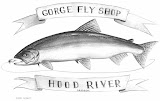Dressing for a fishing trip actually takes a little thought. Each trip is pretty dynamic and certainly hinges on the climate, the forecast and how physical the trip will be. Will you be hiking? Mostly floating – or both? Much like say, hiking, there will be times when you heat up and times when you cool off. Actually, one of these two conditions will likely be happening, unless of course, you find just the perfect temperature and you hold it. This is the key: trying to find just the right temperature while staying functional and making it last as long as possible. But not easy. It’s such a dynamic world out there to begin with, let alone the different tempos of your fishing. Here’s where your garment choice really comes into play. It’s best to be prepared because your comfort makes all the difference between good times and bad. Here’s a few thoughts about how to lay out your wardrobe for the day. Think in layers. By dressing in layers, you will be better able to fine-tune your comfort. Make sure you give careful consideration to Base Layers, Mid Layers and Outer Wear.
Base Layers
Start with the lightest possible layer that you think you will be comfortable to the skin. Consider shirts or, shorts or long underwear that breathes and whisks moisture away from your body. Having breathability is very important. Sweat that collects on your body not only leaves you feeling squishy, but leaves you at risk for becoming cold when your activity level slows or the weather turns. In fact, breathable garments are important for every layer that you pack with you. Here are some base layer suggestions. If you expect hot, sunny conditions, then you also want to consider sun protection in addition to comfort.
 |
| Simms WaderWick Crew |
Mid Layers
Mid layers are typically worn over the base layer, however a few of these can also be worn directly on the skin like a base layer, depending on the temperature of course. The mid layer is a layer you will likely be spending a lot of time in. Often times, this layer will be the first barrier to the elements, and for this reason, they often have some amount of weather proofing – like wind or light rain protection. As stated before, having breathable materials for this layer does a lot for comfort and over-all temperature regulation.
 |
| Simms Guide Fleece |
Mid Layers with Added Weather Protection.
(Wear as inner or outerwear)
Outer Wear– Weather Proof Shells
The days of large, thickly insulated coats are in the past. It was simply too difficult to regulate body temperature. Tactical outerwear now consists of shells using lightweight, breathable and highly waterproof materials. Essentially, the quality of the insulation really comes down to the layers you wear beneath the exterior shell. By layering, you can fine tune your comfort to any situation. However, a quality exterior shell is something you should always bring along. For those conditions where the wind is howling and a heavy rain or snow is coming down on you, a waterproof, yet breathable, shell is the only thing that will keep you dry and comfortable. Here are some outerwear suggestions. The degree of water resistance, breathability as well as durability is fairly indicative of price.
 |
| Patagonia River Salt |
Most of this I have written with the idea that waders or weather proof pants are being worn. How many layers you choose to wear or bring with you really comes down to the weather at hand and the degree of exertion that you expect. Once it becomes cool enough to wear waders in the fall I will either wear a pair of boxers, shorts or a light, full length base layer under the waders. As the weather grows cooler, my layering on the bottom will start to thicken. However, a light base and a well insulated mid layer will often cover you in cold conditions. That said however, there have been some long, cold floats where I have worn 3 layers of bottoms. No sense in shivering on a cold winter day…




















.jpg)




No comments :
Post a Comment